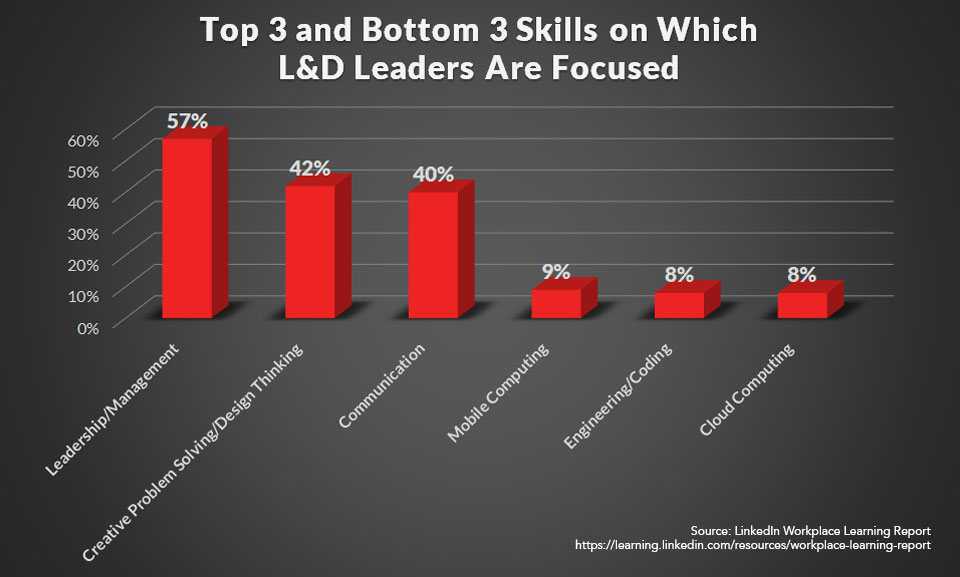Topics
Building Resiliency with Continuous Training of Soft Skills

The past 18 months created a level of disruption, crisis, feelings of isolation, anxiety and trauma rarely experienced by one nation, let alone the world. Yet through it all, human persistence and resilience has shone through.
These months are all about agreeing and acclimating to the next normal we share. And this next normal will likely look different for each industry, each company and each employee. Comfort levels and needs vary greatly by person. Now perhaps more than ever, one size does not fit all.
This series of three blogs will cover steps L&D can take to help your staff adapt to the next normal. Part 2 is about building resiliency in your employees, and your company, through soft skills training.
SKILLS ARE SOFT AND HARD
Hard skills are talents and abilities that can be measured. They can be specific to a particular job, and they can be learned through schooling or mentoring. These skills can include a degree or certification, coding, foreign languages, typing and accounting. Soft skills (a.k.a., behavioral skills) are less defined but are often universal to workplaces. Leadership, teamwork and communication are examples of soft skills.
WORK SOFTLY
Again, the return to “normal” will look different for each person, much less every company. Anxieties and worries can center not only on workplace stress, but also societal expectations, personal problems, systemic issues and other concerns that individuals are facing.
But despite the challenges, many leaders see this return as a golden opportunity to lead and work together more humanely and effectively. It can be a way to reshape how we work and collaborate. Bringing empathy to our interactions can immensely improve working and personal relationships.
EMPATHY, EMERGENT
During the pandemic, the idea and practice of empathy has increased greatly, but obviously the concept of empathy goes back much farther. And while the word is often bandied about, it can be easy to confuse empathy with sympathy.
Empathy is the ability to understand someone else’s feelings as though you were having the feelings yourself. Empathy can also mean projecting our feelings onto a work of art. This is not to be confused with sympathy, which involves taking part in another person’s feelings by feeling sorrowful about their misfortune. You can also show sympathy with tastes or opinions, as in feeling sympathy with a cause or political notion.
Empathy is crucial to life experiences and how we work together when feelings are involved in doing our work. Showing empathy at work can look different depending on your role:
Be present. Each moment of life, and work, is unlike the one before or after it. When focusing on a task or project, try to tackle only what is in front of you and stay in the present. This can help you be more mindful and, ultimately, more productive as you work step by step to accomplish a goal without getting bogged down in the amount of overall work required.
Understand your mood. Doing your best varies day by day and moment by moment. So, some days you may have a lower mood or energy level than others. Try not to beat yourself up if your work takes longer some days than others. Keep focusing on the present and moving forward, no matter what speed.
Ask for, and offer, help. Especially in individualistic societies, workers can feel like they are all on their own. Even amid team members, workloads can overwhelm. Do not be afraid to ask for help. The right teammates will be there to offer it. And when you’re given help, remember it. At some point others will ask you for help. Perhaps you’ll be their support at that time.
Recognize your power. This is especially useful for leaders. Understand how the hierarchical power you have over staff can affect their mood and work level, their accomplishments and engagement. In effect, all employees have the power of empathy, in a sense.
Practice and demonstrate empathy. Working with empathy means understanding where you are, where others are, and meeting one another on the same level where possible.
Teach empathy with empathy. L&D leaders, take note. Empathy is not only useful to teach to others, but also is essential to use every day. Teaching with empathy means you are meeting employees where they are to ensure knowledge is retained while meeting individuals’ needs.
SOFT SKILLS’ SHELF LIFE
The rise of artificial intelligence (AI), machine learning and other automation technologies means many hard skills are being automated. Meanwhile, soft skills are becoming more in demand. According to LinkedIn’s Workplace Learning Report, investing in soft skills is smart as “the shelf life of technical skills is relatively short—less than five years—while strong leadership, creative, and communication skills are always in demand.” Five years is a sharp decline. Not long ago, the shelf life of hard skills was estimated at 10–15 years.
Many executives have noticed this trend and now value soft skills above digital or technical skills. They recognized that such skills will be crucial for future successes.
Workers also have noticed the shift. In our survey of 1,000 employees, only 38 percent were confident in their current set of skills. And 58 percent reported that the top skills they learned in college were problem solving and critical thinking, both soft skills.
In terms of seeking out training and developing skills on their own, employees differ. Some 48 percent of professionals said they sought out learning opportunities, compared to 46 percent of medical workers and 21 percent working in sales/service/retail. These figures suggest that employers and learning professionals should take the reins for consistency and scaling training in the age of automation.
LinkedIn’s report also identified the highest and lowest priority skills that L&D professionals were focused on developing. Soft skills like leadership management (57 percent), creative problem solving/design thinking (42 percent) and communication (40 percent) topped the list. Hard skills like mobile computing (9 percent), engineering and coding (8 percent) and cloud computing (8 percent) rated far lower.

Udemy’s 2021 Workplace Learning Trends report delves further. Their research showed that consumption of soft skills training grew greatly over 2019. In the past year-plus, employees have increased time spent learning soft skills, such as time management (+990 percent), motivation (+855 percent), listening (+1,650 percent), business communication (+1,585 percent) and decision making (+1,240 percent).
With figures like these and executive buy-in, it’s clear that for L&D professionals to succeed in 2021 and beyond, developing and honing soft skills should be a key focus.
BENEFITS OF SOFT SKILLS
Hiring employees with advanced soft skills can significantly impact an organization’s ability to function effectively, within its own structure and as part of their industry. For example, in sales-focused companies, empowering staff with strong communication and teamwork skills will have a direct impact on customer experience, as well as profits.
If you’re in a management or recruitment position, don’t underestimate the value that workers with high-level soft skills can bring to your organization. Those who can handle conflicts, perform well under pressure and work well as part of a team are all very valuable skills for any employee. Additionally, staff who possess soft skills tend to manage more satisfying relationships, which leads to better workplace outcomes and a more positive work culture for everyone.
TEACHING SOFT SKILLS
Soft skills are often underrated or neglected in the workplace, so it’s important for individuals to recognize the link between these qualities and career success. Organizations may not provide set training in soft skills, but L&D leaders should look at avenues to develop them.
Online learning is a great way to boost soft skills. Through eLearning, you can improve existing skills or learn something completely new, in a time and place that’s convenient for staff. With the proliferation of smart devices and fast network speeds, companies can push eLearning via multiple modalities, such as video vignettes, social learning, text-based courses and more. Staff could even use their daily commute to develop abilities on the go.

For more kinesthetic learners, you can create role-play scenarios to explore ways to learn interpersonal skills, such as people management, effective communication and the all-important empathy. Build relatable stories and situations, not trite conversations, that teach employees to apply soft skills in their daily lives.
EMPATHY IN ACTION
In whatever ways you apply soft skills training across your enterprise, let’s recall one of the earlier bullets: Teach empathy with empathy. This phrase could be expanded to work with empathy. There are as many types of learners and workers as there are people and personalities. It can be daunting to capture them all in your L&D program. However, that doesn’t mean we stop trying. We want no one feeling left behind in developing her or his skills and experience.
And even as the pandemic subsides for many people, agility and the ability to adapt have never been more critical. It won’t stop in the next normal. Agility and flexibility are the next normal.
If you’re rethinking or redesigning your learning and professional development, why not reach out to one of our experts for a demonstration of how powerful L&D can reshape organizations.

